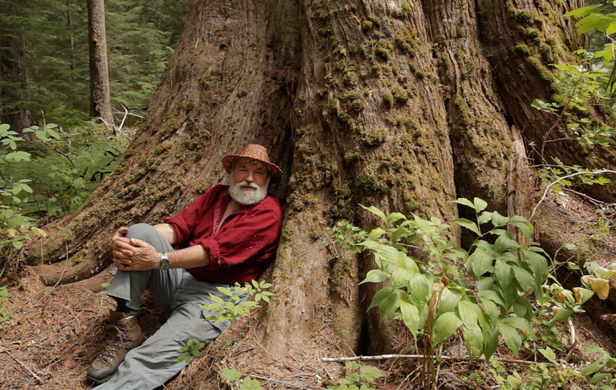
How do we value wilderness? What metrics should we apply to an 1,800-year-old tree, or the tiny lichens that make their home on it? What numbers do we input into our calculator – ecosystem services rendered, tonnes of carbon sequestered, cubic metres of merchantable timber, jobs created? These are the questions that came to mind while filming my latest documentary, “Primeval: Enter the Incomappleux”, deep in the heart of the Selkirk Mountains in BC’s Kootenay region.
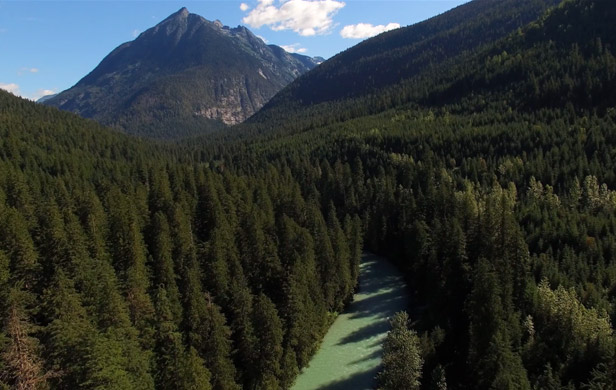
Depending on the metrics, one can arrive at starkly different answers as to the fate of our few remaining old-growth forests. After decades of clearcuts have made a checkerboard out of BC’s wild places, the Incomappleux is left in a rare category: one of the last truly intact stretches of temperate rainforest here or anywhere – growing continuously since the last Ice Age, forgotten by human time and imprint. To walk amongst its 25,000 hectares of ancient cedars and hemlocks is to get lost in nature in a way that was likely normal to First Nations inhabiting this land for the past 10,000 years, yet all but unknown to today’s British Columbians.
I had the unique privilege of entering the Incomappleux – no easy feat as access roads and bridges have been washed out by Mother Nature – to document a team of scientists and conservationists, led by Valhalla Wilderness Society, and their work to protect this place through a provincial park that would encompass a grand total of 156,000 hectares.
The result is a new 20-minute film premiering tonight (Nov. 23) at the Vancouver International Mountain Film Festival, with a repeat showing tomorrow (Nov. 24) at UBC’s Forest Sciences Centre (detailed info below). I hope it will provide audiences with even a small sense of the awe and wonder this place inspired in me.
Numbers game
But these feelings, and the demonstrated psychological and health benefits from spending time in wilderness, are hard to quantify in dollar terms. Nevertheless, it is difficult to deny that our present-day society, through its growing disconnection with nature, is losing something essential to the human experience.
But let’s deal for a moment with the metrics we do understand – as they have been drilled into us by countless industry op-eds, “position papers” by right-wing think tanks, and, broadly speaking, our mainstream media. Many of us have come to accept certain assumptions about the importance and nature of our “resource economy” – which are often incorrect.
A “decadent” forest
Let’s look at the Incomappleux as an example. It is currently covered by Category-A cut blocks owned by international forestry giant Interfor. Under a true “free market”, it would never be logged. This is because ancient trees hold little value as merchantable timber – they begin to rot from the inside out, even while they’re still standing.
The industry and government refer to these forests as “decadent”, which means “decaying” and “self-indulgent” – in other words, “How dare this tree be so selfish as to put its own existence ahead of what would be a much more economically productive monoculture tree farm.” This has been the way things are done in BC’s forests for decades: mow down and remake these “decadent” old-growth forests in humans’ image and to our exclusive, commercial benefit. What other reason could this forest have for existing, other than to serve our immediate needs?
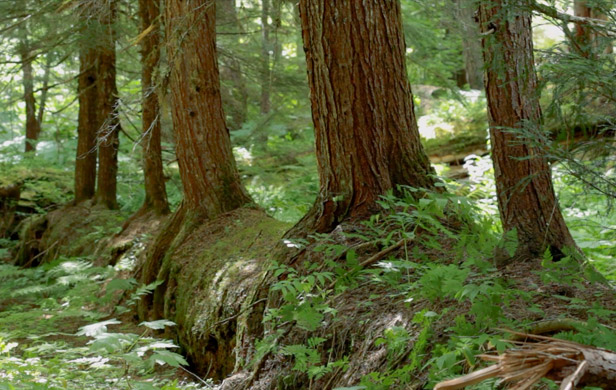
But that “decadent” tree is providing many invaluable services to its ecosystem and the climate – by sequestering large volumes of carbon, which does very much concern us humans. When it keels over, this tree’s rich nutrients will seep back into the soil, feeding millions of organisms. New trees will sprout upon its back. I filmed one red cedar in the Incomappleux that was up to 1,500 years old when it died. Its corpse – very much still kicking around today – has a 300-year-old tree growing out of it. That puts the nurse log’s origin roughly at the time of Roman Emperor Marcus Aurelius or his son Commodus (as depicted in the film Gladiator). Surrounding this tree are myriad lichens, fungi, mosses and insects, all benefitting from this one “decadent” tree.
The lichen-caribou connection

The lichens are of particular import as they feed endangered Mountain Caribou in winter months, when higher elevation slopes are out of reach. Those caribou are in free-fall (36% decline throughout the region since the provincial government’s 2008 recovery program was instituted).
This is chiefly attributable to habitat loss (not the frequent scapegoat, wolves). So if we keep logging these valleys, we will preside, sooner than later, over the extinction of a marvellous species. How does the value of caribou survival fit into our economic matrix?
Subsidizing old-growth logging
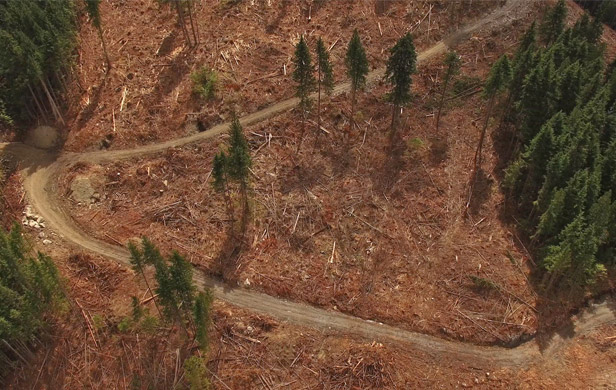
Back to those cut blocks. Not only do these trees hold little commercial value, but the valley’s remoteness means the cost of harvesting is high. Combine that with the fact that many smaller, local mills which used to create jobs for communities in the Kootenays have been shuttered in recent decades, in favour of larger, more centralized, often foreign-owned mega mills. That means greater trucking distances = greater cost. Ergo, the Incomappleux is highly uneconomical to log.
That’s where our “free enterprise” government intervenes in the market, offering steep corporate handout discounts on stumpage fees to incentivize logging in these uneconomical places. A rate that can be as high as $20/cubic metre falls to as low as 25 cents. What should have fallen short when evaluated by our economic calculator is now magically viable for logging.
Ancient forests still on chopping block
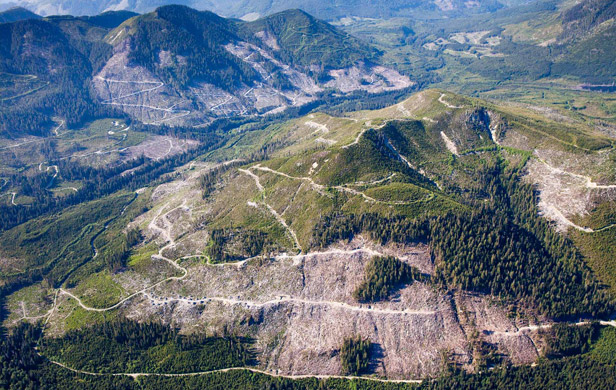
That’s not to say that Interfor will log it tomorrow, but this is how it could very easily happen. And it is happening around the province as we speak. On Vancouver Island – where 9,000 hectares of old-growth are still logged each year – at a place called East Creek, stumpage has been as low as 27 cents/cubic meter. This is, sadly, not particularly uncommon amongst hard-to-access old-growth forests on the coast and in the Kootnenays’ inland forests.
Bear in mind that these are public forests (private lands in BC carry no stumpage fees and even less regulation and oversight). Public forests are a crown asset and when our government gives away timber for pennies on the dollar, that is revenue that isn’t going to schools or hospitals – let alone being reinvested in regulating or modernizing the forestry sector. When local mills are closed in favour of bigger, central ones and logs are shipped overseas for processing, we are losing thousands of jobs in the bargain.
Raw deal
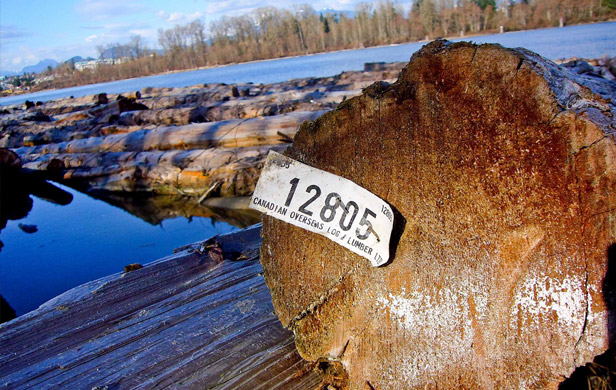
On that note, here are some more numbers that should give us pause: Last year alone, we saw 7 million cubic metres of wood leave this province in the form of raw logs – that’s enough lumber to frame 165,000 new homes in BC, according to researcher Ben Parfitt. All this, combined with other examples of mismanagement, has meant a steep decline in forestry jobs in BC – from 100,000 or so at the 1995 peak to around 65,000 today. So out-of-whack is the BC situation that as of 2012, according to Stats Canada, it took 1,312 cubic metres of harvested wood to create one full-time forestry job in BC – compared with just 292 cubic metres for the same job in Ontario.
Let me be clear: My family has worked in BC’s forestry sector for a century or more. I take very seriously the jobs the sector has provided to the province’s workforce. But there are many intelligent ways, through improved management and innovation, that we could bring jobs back without sacrificing the few remaining bits of true wilderness we have left. Not to mention a whole new economy out there in the form of clean tech, the creative sectors, value-added manufacturing and Supernatural BC tourism that we’re forgetting about.
A different calculus
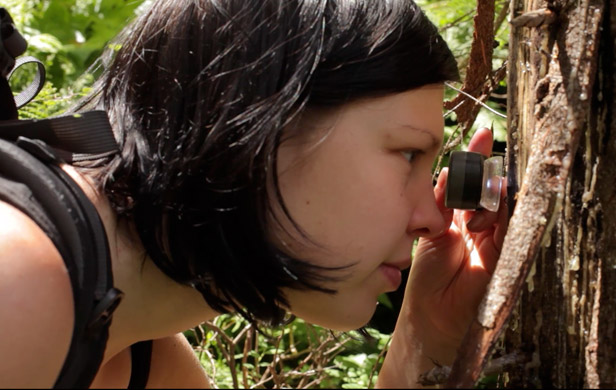
Moreover, standing in the heart of the Incomappleux, towering cedars swaying overhead, the mists welling up from Battle Brook below, moistening the mosses and hair lichens, it strikes one that there just may be deeper values than jobs, stumpage fees, and cubic metres of harvestable timber. Unfortunately, I can’t hope to do this revelation justice with my camera or mere words. Proud though I am of what we captured on this journey and excited to share it on the big screen, nothing can come close to the experience of being there. In that sense, I fear, numbers will always win out.
If that’s the case, then here are a few more figures to tabulate:
• 0.5% – the total of the planet’s land surface that these temperate rainforests covered, at their peak
• 10% – the amount of old-growth left on Vancouver Island today (1% if you look deeper into specific species like Douglas Fir on Southeast Vancouver Island)
• One tonne – the amount of carbon a single ancient tree is capable of storing
Seeing the forest for the trees
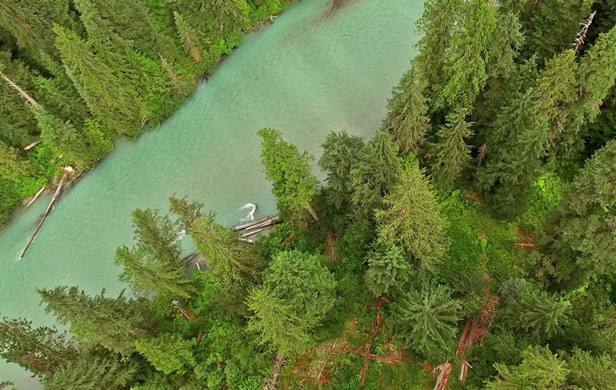
Alas, I suppose I’ve fallen into a trap in recent years. Hungry for credibility in the eyes of mainstream media, government and industry, I’ve sought to confront difficult conversations about resource projects based on the terms laid out by their proponents: i.e. engaging with claims of jobs and public benefits, questioning economic studies from the Fraser Institute and the like.
Meanwhile, my old pal and co-founder of this publication, Rafe Mair has often preferred to talk about the spiritual dimension of these issues. He speaks of wild salmon and free-running rivers as the soul of our province. Perhaps I didn’t get it, until now.
But there was a time when I did. When I was 10 years old, my aunt Vivian – a lone environmentalist amongst 5 brothers in the oil and gas industry (my mother, as a teacher, got a pass from both camps) – put me onto a campaign to protect the Carmanah Valley on Vancouver Island, where I grew up. I took the petition around my school and neighbourhood and was proud to sign up a few dozen names. My bedroom wall was graced by a poster of the valley, staring up at four iconic sitka spruce, sun glittering through the needles of the canopy. I never went there, but even that picture instilled a sense of peace in me growing up.
Then I forgot all about it and went off into the world to make money.
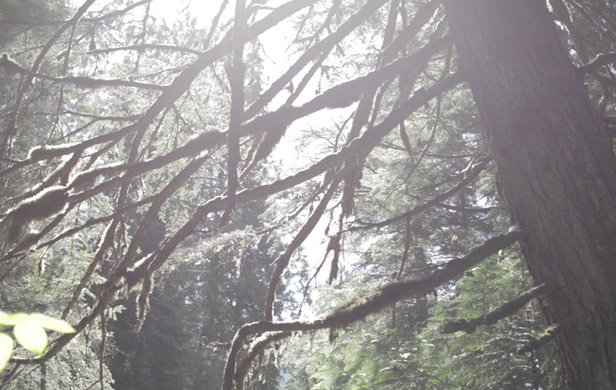
Going to the Incomappleux reawakened in me that sense of calm and wonder at the natural world. And I understood Rafe’s point. There are some values that can’t easily be quantified. Call it quaint or naïve in this complex modern economy, if you will. But there is a soul in those trees and lichens – and, perhaps, in us too. Who are we to decide whether they exist or disappear forever into the annals of human time?
Yet, unlike many environmental battles in BC’s ancient and recent history, the story of the Incomappleux need not have any villains or losers. There is only this: a place so perfect and rare that once lost it can never be recreated; a company that could easily be compensated for relinquishing its tenures, which, without government intervention that would make Karl Marx blush, have no economical value; and a chance to leave a splendid legacy for the caribou, the lichens, the cedars and hemlocks, and our own children and future generations. So one day, my son or your granddaughter can have the opportunity to stare up at that canopy, feel the cool breeze on their cheek and forget all about the facts, figures, and petty concerns of our man-made world.
Sign Valhalla’s Selkirk Mountain Caribou Park petition here – and see “Primeval: Enter the Incomappleux” at two Vancouver screenings:
• Tonight (Wed, Nov. 23) @ Vancouver’s Rio Theatre – 7:30-10PM (doors open 6:30). Part of VIMFF’s “Back to the Roots” night – also featuring short films by Daniel Pierce and Darryl Augustine, presentations by TJ Watt and Craig Pettitt and a Q&A with them, Damien Gillis and lichen expert Dr. Toby Spribille. Tickets available online here or at the door.
• Thursday, Nov. 24 @ UBC Forest Sciences Centre (2424 Main Mall – Room 1005) – 6:30-8PM. Featuring panel discussion with Prof. Suzanne Simard (see her incredible TED talk), Dr. Toby Spribille, Craig Pettitt, Damien Gillis and moderator Ngaio Hotte.
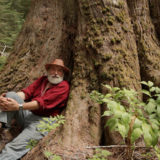

Damien, I would like to thank you for this article, and I hope to one day view the film. While I expect we likely agree on many issues, I want to point out how important, if these battles are to be won, to avoid language that alienates potential collaborators and supporters. Today, the battle is not between “right-wing” and left, nor even betwixt you and “the Fraser Institute and the like”.
We are all finding strange bedfellows these days as we awaken from the deceptively-induced stupor of the last century, and sensible folk need to stick together, not divide. The “new dichotomies” are much more around big versus small, local versus global, centralization versus distribution, individualism versus collectivism, organic versus engineered, planning and control versus adaptation, and freedom versus coercion. There is only one universal unifier: truth. There is no greater pursuit. You felt its absence when you pursued money instead. So did I. Welcome back.
You bemoan the monetization of our economy, but who asks (and answers) why and how has this occurred? It has not always been so. It was taking our eye off the financial-ball that has allowed most of what you bemoan to occur. Our money-economies did not have to be engineered so that they demanded incessant growth. We did not need to demean and diminish valuable but non-monetary roles by creating the need for multiple incomes per family unit. We did not need to render our economies so fragile and inefficient. We do not need, cannot rationally want, nor can we sustain big-government in cahoots with big-business, which is what we have allowed to evolve.
We absolutely need organizations like the Fraser Institute, and many others, to keep tabs on the out-of-control juggernauts that claim to be, but are not, working in our best interests. The Fraser Institute will not throw me in jail if I fail to support their policies. My governments will. The Fraser Institute does not sell old-growth forests it doesn’t own. One could go on. I doubt I agree with all their policy positions, but do not throw out babies, no matter how dirty the bath, please.
The sooner we all recognize like Pogo that the enemy is “us”, not “them”, the sooner we start leaving institutional madness and returning to institutional sanity.
But it requires research, disciplined reasoning, and re-evaluation of political positions around the new dichotomies I mention above. Please open your mind, but then, as G.K Chesterton suggests, use it just like your mouth, and make sure to close it again on something solid.
Again, my thanks for your work.
J. B. Bacque
Crimes against our environment which this clearly is should be met with stiff fines and incarceration. Unfortunately we have governments in Ottawa and BC who are on side with any and all forms of commerce…no matter the permanent, negative outcome. Christy and Justin seem to have a price tag for everything. They both suggest that they are stewards of our environment. The both lie.
where is this location exactly,,please…
The Central Selkirks – south of Glacier National Park, North of Goat Range Park. Nearest town is Beaton, BC. Beautiful country!
Thank you. I live in Tahsis, and the chain saws are roaring daily as the slopes are shaved and the rain pounds down, eroding the earth, silting the streams, ruining the spawning channels and making profit for Western Forest Products. Last year they went into the Canton valley and stripped that magical place , leaving behind enough wasted wood to rebuild the city of Victoria…why do they cut down trees if they’re just going to leave them lying on the ground?
What has been done to the forests of Vancouver Island is so wasteful, so short-sighted and so completely stupid those who allowed it should be ashamed… and should be forced by law to live in the macerated landscape they helped make.
Again, thank you, for this article and for this film.
when is this film coming to victoria? advance notice please for us living on gulf islands. thanks, Susan Q
Hi Susan. Sometime in the New Year. May even make over to Salt Spring but for sure Victoria. Stay tuned 🙂